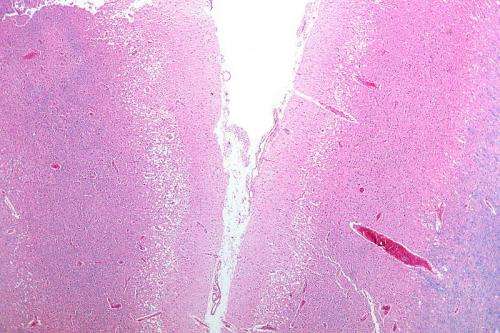Treatment outcomes of brain hemorrhage after thrombolysis for stroke

Treating brain hemorrhage (symptomatic intracerebral hemorrhage, sICH) after clot-busting thrombolysis for stroke was not associated with a reduced likelihood of in-hospital death or expansion of the hematoma but shortening time to diagnosis and treatment may be key to improving outcomes, according to an article published online by JAMA Neurology.
Intravenous thrombolytic therapy with recombinant tissue plasminogen activator (rtPA) can improve outcomes for patients with ischemic stroke treated within 4½ hours of the onset of symptoms. The most serious complication of thrombolysis is sICH, which was reported in 6 percent of patients with stroke in the National Institute of Neurological Disorders and Stroke rtPA trials. Although it is an infrequent complication, sICH is associated with a high mortality rate near 50 percent.
Shadi Yaghi, M.D., of Brown University, Providence, R.I., and colleagues analyzed data from 10 stroke centers across the United States to understand the natural history of thrombolysis-related sICH and to focus on the efficacy of various treatments used. The authors looked at outcomes for in-hospital death and hematoma expansion.
There were 3,894 patients treated with rtPA between January 2009 and April 2014; among them 128 patients (3.3 percent) had sICH. Of those 128 patients, 38.2 percent (49 patients) received any treatment for sICH and 28.9 percent (37 patients) had their code status changed to comfort measures within the first 24 hours after sICH diagnosis.
The authors report the most commonly used treatment was the frozen blood product cryoprecipitate (31.3 percent [40 of 128]). The median time from initiation of rtPA therapy to sICH diagnosis was 470 minutes and the median time from sICH diagnosis to treatment of sICH was 112 minutes.
The in-hospital mortality rate was 52.3 percent (67 of 128 patients) and 26.8 percent of patients (22 of 82) had hematoma expansion. A change in code status to comfort measures after sICH diagnosis was the only factor associated with increased in-hospital death, according to the results.
The authors note the effects of therapy may be underestimated because few patients received each of the sICH treatments.
"In this study, treatment of postthrombolysis sICH did not significantly reduce the likelihood of in-hospital mortality or hematoma expansion. Shortening the time to diagnosis and treatment may be a key variable in improving outcomes of patients with sICH," the study concludes.
In a related editorial, Tiffany Cossey, M.D., and Nicole R. Gonzales, M.D., of The University of Texas Health Science Center at Houston, write: "Although sICH may be an uncommon occurrence, the known risk weighs heavily on the decision of clinicians to administer tPA [intravenous tissue plasminogen activator], as well as on the decisions of patients and families regarding treatment. It is worthwhile to dedicate efforts to minimizing the risk of this complication for both the direct and indirect benefits."
More information: JAMA Neurol. Published online October 26, 2015. DOI: 10.1001/jamaneurol.2015.2371
JAMA Neurol. Published online October 26, 2015. DOI: 10.1001/jamaneurol.2015.2900













